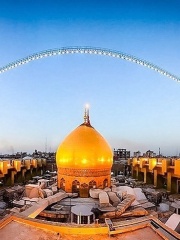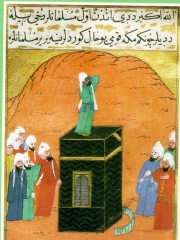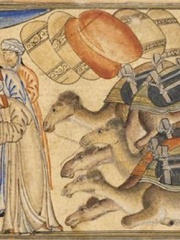







The Most Famous
RELIGIOUS FIGURES from Saudi Arabia
This page contains a list of the greatest Saudi Arabian Religious Figures. The pantheon dataset contains 3,187 Religious Figures, 88 of which were born in Saudi Arabia. This makes Saudi Arabia the birth place of the 8th most number of Religious Figures behind United Kingdom, and Spain.
Top 10
The following people are considered by Pantheon to be the top 10 most legendary Saudi Arabian Religious Figures of all time. This list of famous Saudi Arabian Religious Figures is sorted by HPI (Historical Popularity Index), a metric that aggregates information on a biography's online popularity. Visit the rankings page to view the entire list of Saudi Arabian Religious Figures.

1. Muhammad (570 - 632)
With an HPI of 100.00, Muhammad is the most famous Saudi Arabian Religious Figure. His biography has been translated into 223 different languages on wikipedia.
Muhammad (c. 570 – 8 June 632 CE) was an Arab religious, military and political leader, as well as the founder of Islam. According to Islam, he was a prophet who was divinely inspired to preach and confirm the monotheistic teachings of Adam, Noah, Abraham, Moses, Jesus, and other prophets. He is believed by Muslims to be the Seal of the Prophets, and along with the Quran, his teachings and normative examples form the basis for Islamic religious belief. According to the traditional account, Muhammad was born in Mecca to the aristocratic Banu Hashim clan of the Quraysh. He was the son of Abdullah ibn Abd al-Muttalib and Amina bint Wahb. His father, Abdullah, the son of tribal leader Abd al-Muttalib ibn Hashim, died around the time Muhammad was born. His mother Amina died when he was six, leaving Muhammad an orphan. He was raised under the care of his grandfather, Abd al-Muttalib, and paternal uncle, Abu Talib. In later years, he would periodically seclude himself in a mountain cave named Hira for several nights of prayer. When he was 40, in c. 610, Muhammad reported being visited by Gabriel in the cave and receiving his first revelation from God. In 613, Muhammad started preaching these revelations publicly, proclaiming that "God is One", that complete "submission" (Islām) to God (Allāh) is the right way of life (dīn), and that he was a prophet and messenger of God, similar to other prophets in Islam. Muhammad's followers were initially few in number, and experienced persecution by Meccan polytheists for 13 years. To escape ongoing persecution, he sent some of his followers to Abyssinia in 615, before he and his followers migrated from Mecca to Medina (then known as Yathrib) later in 622. This event, the Hijrah, marks the beginning of the Islamic calendar, also known as the Hijri calendar. In Medina, Muhammad united the tribes under the Constitution of Medina. In December 629, after eight years of intermittent fighting with Meccan tribes, Muhammad gathered an army of 10,000 Muslim converts and marched on the city of Mecca. The conquest went largely uncontested, and Muhammad seized the city with minimal casualties. In 632, a few months after returning from the Farewell Pilgrimage, he fell ill and died. By the time of his death, most of the Arabian Peninsula had converted to Islam. The revelations (waḥy) that Muhammad reported receiving until his death form the verses (āyah) of the Quran, upon which Islam is based, and are regarded by Muslims as the verbatim word of God and his final revelation. Besides the Quran, Muhammad's teachings and practices, found in transmitted reports, known as hadith, and in his biography (sīrah), are also upheld and used as sources of Islamic law. Apart from Islam, Muhammad has received praise in Sikhism as an inspirational figure, in the Druze faith as one of the seven main prophets, and in the Baháʼí Faith as a Manifestation of God.

2. Ali (601 - 661)
With an HPI of 89.31, Ali is the 2nd most famous Saudi Arabian Religious Figure. His biography has been translated into 122 different languages.
Ali ibn Abi Talib (Arabic: عَلِيُّ بْن أَبِي طَالِب, romanized: ʿAlī ibn Abī Ṭālib) (c. 600 – 661 CE) was the fourth Rashidun caliph who ruled from 656 CE until his assassination in 661, as well as the first Shia Imam. He was the cousin and son-in-law of the Islamic prophet Muhammad. Born to Abu Talib ibn Abd al-Muttalib and Fatima bint Asad, Ali was raised in the household of his cousin Muhammad and was among the first to accept his teachings. Ali played a pivotal role in the early years of Islam when Muslims were severely persecuted in Mecca. After the immigration (hijra) to Medina in 622, Muhammad gave his daughter Fatima to Ali in marriage and swore a pact of brotherhood with him. Ali served as Muhammad's secretary and deputy in this period, and was the flag bearer of his army. Numerous sayings of Muhammad praise Ali, the most controversial of which was uttered in 632 at the Ghadir Khumm, "Whoever I am his mawla, then Ali is his mawla." The interpretation of the polysemous Arabic word mawla is disputed: For Shia Muslims, Muhammad thus invested Ali with his religious and political authority, while Sunni Muslims view this as a mere statement of friendship and rapport. When Muhammad died in the same year, a group of Muslims met in the absence of Ali and appointed Abu Bakr (r. 632–634) as their leader. Ali later relinquished his claims to leadership and resigned from public life during the reigns of Abu Bakr and his successor, Umar (r. 634–644). Even though his advice was occasionally sought, the conflicts between Ali and the first two caliphs are epitomized by his refusal to follow their practices. This refusal cost Ali the caliphate to the benefit of Uthman (r. 644–656), who was thus appointed to succeed Umar by the electoral council. Ali was also highly critical of Uthman, who was widely accused of nepotism and corruption. Yet Ali also repeatedly mediated between the caliph and the provincial dissidents angered by his policies. Following Uthman's assassination in June 656, Ali was elected caliph in Medina. He immediately faced two separate rebellions to avenge Uthman: The triumvirate of Talha, Zubayr, both companions of Muhammad, and his widow Aisha captured Basra in Iraq but were defeated by Ali in the Battle of the Camel in 656. Elsewhere, Mu'awiya, whom Ali had removed the governorship of Syria, fought against Ali in the inconclusive Battle of Siffin in 657, which ended in a failed arbitration process that alienated some of Ali's supporters. These formed the Kharijites, who later terrorized the public and were crushed by Ali in the Battle of Nahrawan in 658. Ali was assassinated in 661 by the Kharijite dissident Ibn Muljam, which paved the way for Mu'awiya to seize power and found the dynastic Umayyad Caliphate. Ali is revered for his courage, honesty, unbending devotion to Islam, magnanimity, and equal treatment of all Muslims. For his admirers, he has thus become the archetype of uncorrupted Islam and pre-Islamic chivalry. Sunni Muslims regard him as the last of the rashidun (lit. 'rightly-guided') caliphs, while Shia Muslims venerate him as their first Imam and the rightful religious and political successor to Muhammad. Ali's place is said to be second only to Muhammad in Shia Muslim culture. The shrine of Ali in Najaf, Iraq, is a major destination for Shia pilgrimage. The legacy of Ali is collected and studied in numerous books, the most famous of which is Nahj al-balagha.

3. Abu Bakr (573 - 634)
With an HPI of 89.08, Abu Bakr is the 3rd most famous Saudi Arabian Religious Figure. His biography has been translated into 110 different languages.
Abd Allah ibn Abi Quhafa (Arabic: عَبْدُ اللهِ بْنُ أَبِي قُحَافَةَ, romanized: ʿAbd Allāh ibn ʾAbī Quḥāfa) (c. 573 – 23 August 634), better known by his kunya Abu Bakr, was a senior companion, the closest friend, and father-in-law of Muhammad, the Islamic prophet. He served as the first caliph of the Rashidun Caliphate, ruling from 632 until his death in 634. Abu Bakr was granted the honorific title al-Ṣiddīq (lit. the Veracious) by Muhammad, a designation that continues to be used by Sunni Muslims to this day. Born to Abu Quhafa and Umm al-Khayr of the Banu Taym, Abu Bakr was among the earliest converts to Islam and propagated dawah to the Mushrikites. He was considered the first Muslim missionary, as several companions of Muhammad converted through Abu Bakr. He accompanied Muhammad on his migration to Medina and became one of his bodyguards. Abu Bakr participated in all of Muhammad's campaigns and served as the first amir al-hajj in 631. In the absence of Muhammad, Abu Bakr led the prayers. Following Muhammad's death in 632, Abu Bakr succeeded the leadership of the Muslim community as the first caliph, being elected at Saqifa. His election was contested by a number of rebellious tribal leaders. During his reign, he overcame a number of uprisings, collectively known as the Ridda Wars, as a result of which he was able to consolidate and expand the rule of the Muslim state over the entire Arabian Peninsula. He also commanded the initial incursions into the neighboring Sasanian and Byzantine empires, which in the years following his death, would eventually result in the Muslim conquests of Persia and the Levant. Apart from politics, Abu Bakr is also credited for the compilation of the Quran, of which he had a personal caliphal codex. Prior to dying in August 634, Abu Bakr nominated Umar (r. 634–644) as his successor. Along with Muhammad, Abu Bakr is buried in the Green Dome at the Al-Masjid an-Nabawi in Medina, the second holiest site in Islam. He died of illness after a reign of 2 years, 2 months and 14 days, the only Rashidun caliph to die of natural causes. Though Abu Bakr's reign was brief, it included successful invasions of the two most powerful empires of the time, the Sassanian Empire and the Byzantine Empire. He set in motion a historical trajectory that, within a few decades, would lead to the establishment of one of the largest empires in history. His decisive victory over the local Arab rebel forces marks a significant chapter in Islamic history. Sunni tradition reveres Abu Bakr as the first of the Rashidun caliphs and the greatest individual after the prophets and messengers, while Shia tradition views Abu Bakr as a usurper of the caliphate and an adversary of the ahl al-bayt.

4. Husayn ibn Ali (626 - 680)
With an HPI of 83.63, Husayn ibn Ali is the 4th most famous Saudi Arabian Religious Figure. His biography has been translated into 85 different languages.
Husayn ibn Ali (Arabic: الحسين بن علي, romanized: al-Ḥusayn ibn ʿAlī; 11 January 626 – 10 October 680 CE) was a social, political and religious leader in early medieval Arabia. The grandson of the Islamic prophet Muhammad and an Alid (the son of Ali ibn Abi Talib and Muhammad's daughter Fatima), as well as a younger brother of Hasan ibn Ali, Husayn is regarded as the third Imam in Shia Islam after his brother, Hasan, and before his son, Ali al-Sajjad. Husayn is a prominent member of the Ahl al-Bayt and is also considered to be a member of the Ahl al-Kisa and a participant in the event of the mubahala. Muhammad described him and his brother, Hasan, as the leaders of the youth of paradise. During the caliphate of Ali, Husayn accompanied him in wars. After the assassination of Ali, he obeyed his brother in recognizing the Hasan–Mu'awiya treaty, despite it being suggested to do otherwise. In the nine-year period between Hasan's abdication in AH 41 (660) and his death in AH 49 or 50 (669 or 670), Hasan and Husayn retreated to Medina, trying to keep aloof from political involvement for or against Mu'awiya I. After the death of Hasan, when Iraqis turned to Husayn, concerning an uprising, Husayn instructed them to wait as long as Mu'awiya was alive due to Hasan's peace treaty with him. Prior to his death, Mu'awiya appointed his son Yazid as his successor, contrary to the Hasan–Mu'awiya treaty. When Mu'awiya I died in 680, Yazid demanded that Husayn pledge allegiance to him. Husayn refused to do so. As a consequence, he left Medina, his hometown, to take refuge in Mecca in AH 60 (679). There, the people of Kufa sent letters to him, invited him to Kufa and asked him to be their Imam and pledged their allegiance to him. On Husayn's way to Kufa with a retinue of about 72 men, his caravan was intercepted by a 1,000-strong army of the caliph at some distance from Kufa. He was forced to head north and encamp in the plain of Karbala on 2 October, where a larger Umayyad army of some 4,000 or 30,000 arrived soon afterwards. Negotiations failed after the Umayyad governor Ubayd Allah ibn Ziyad refused Husayn safe passage without submitting to his authority, a condition declined by Husayn. Battle ensued on 10 October during which Husayn was killed along with most of his relatives and companions, while his surviving family members were taken prisoner. The battle was followed by the Second Fitna, during which the Iraqis organized two separate campaigns to avenge the killing of Husayn; the first one by the Tawwabin and the other one by Mukhtar al-Thaqafi and his supporters. The Battle of Karbala galvanized the development of the pro-Alid party (Shi'at Ali) into a unique religious sect with its own rituals and collective memory. It has a central place in the Shi'a history, tradition, and theology, and has frequently been recounted in Shi'a literature. For the Shi'a, Husayn's suffering and martyrdom became a symbol of sacrifice in the struggle for right against wrong, and for justice and truth against injustice and falsehood. It also provides the members of the Shi'a faith with a catalog of heroic norms. The battle is commemorated during an annual ten-day period during the Islamic month of Muharram by many Muslims especially Shi'a, culminating on tenth day of the month, known as the day of Ashura. On this day, Shi'a Muslims mourn, hold public processions, organise religious gathering, beat their chests and in some cases self-flagellate. Sunni Muslims likewise regard the incident as a historical tragedy; Husayn and his companions are widely regarded as martyrs by both Sunni and Shi'a Muslims.

5. Hasan ibn Ali (624 - 670)
With an HPI of 81.21, Hasan ibn Ali is the 5th most famous Saudi Arabian Religious Figure. His biography has been translated into 69 different languages.
Hasan ibn Ali (Arabic: الحسن ابن علي, romanized: al-Ḥasan ibn ʿAlī; c. 625 – 2 April 670) was an Alid political and religious leader. The eldest son of Ali and Fatima and a grandson of the Islamic prophet Muhammad, Hasan briefly ruled as caliph from January 661 until August 661. He is considered as the second Imam in Shia Islam, succeeding Ali and preceding his brother Husayn. As a grandson of the prophet, he is part of the ahl al-bayt and the ahl al-kisa, and also participated in the event of the mubahala. During the caliphate of Ali (r. 656–661), Hasan accompanied him in the military campaigns of the First Fitna. Following Ali's assassination in January 661, Hasan was acknowledged caliph in Kufa. His sovereignty was not recognized by Mu'awiya ibn Abi Sufyan (r. 661–680), the governor of Syria and a rival claimant to the caliphate, who led an army into Kufa while pressing Hasan for abdication in letters. In response, Hasan sent a vanguard under Ubayd Allah ibn al-Abbas to block Mu'awiya's advance until he arrived with the main army. Meanwhile, Hasan was severely wounded in an abortive assassination attempt by Al-Jarrah Ibn Sinan, a member of the Kharijites, a faction opposed to both Ali and Mu'awiya. This attack demoralised Hasan's army and led to widespread desertion. Ubayd Allah and most of his troops also defected after Mu'awiya bribed him. In August 661, Hasan signed a peace treaty with Mu'awiya on the condition that the latter should rule in compliance with the Quran and the Sunnah, a council should appoint his successor, and Hasan's supporters would receive amnesty. Hasan retired from politics and abdicated in Medina where he died either from illness or poisoning, though the early sources are nearly unanimous that he was poisoned. Mu'awiya is commonly viewed as the instigator in the murder of Hasan, which removed an obstacle to the succession of his son Yazid I (r. 680–683). Critics of Hasan call his treaty with Mu'awiya an indication of weakness, saying that he intended to surrender from the beginning. Given Mu'awiya's military superiority, supporters of Hasan maintain that his abdication was inevitable after his soldiers mutinied and that he was motivated by the desire for unity and peace among Muslims, which was reportedly predicted by Muhammad in a Sunni hadith. Another Sunni hadith, also attributed to Muhammad, predicted that the prophetic succession would last for thirty years, which may have been interpreted by some early Sunni scholars as evidence that Hasan's caliphate was rightly-guided (rāshid). In Shia theology, the divine infallibility (isma) of Hasan as the second Shia Imam further justified his course of action. As the rightful successor of Muhammad in Shia Islam, Hasan's all-inclusive temporal and religious authority came from divinely-inspired designation (nass), which was not annulled by abdication to Mu'awiya I, who usurped only the temporal authority. The imamate and caliphate are viewed as separate institutions in Shia Islam until such time that God would make the Imam victorious.

6. Bilal ibn Rabah (580 - 642)
With an HPI of 80.86, Bilal ibn Rabah is the 6th most famous Saudi Arabian Religious Figure. His biography has been translated into 55 different languages.
Bilal ibn Rabah (Arabic: بِلَال بْن رَبَاح, romanized: Bilāl ibn Rabāḥ; 5 March 580 - 2 March 640 CE), also known as Bilāl al-Ḥabashī or simply Bilal, was a close companion of the Islamic prophet Muhammad. Born in Mecca, he was of Abyssinian descent and was formerly enslaved. He is considered the first muʾazzin (caller to prayer) in Islam, personally chosen by Muhammad for his deep and melodious voice. According to Islamic tradition, Bilal was one of the earliest converts to Islam and is often regarded as the first African or Black Muslim. He died in 640 CE, around the age of 59.

7. Abdullah ibn Abd al-Muttalib (548 - 570)
With an HPI of 79.87, Abdullah ibn Abd al-Muttalib is the 7th most famous Saudi Arabian Religious Figure. His biography has been translated into 56 different languages.
Abdullah ibn Abd al-Muttalib (; Arabic: عبد الله بن عبد المطلب, romanized: ʿAbd Allāh ibn ʿAbd al-Muṭṭalib; c. 546–570) was the father of the Islamic prophet Muhammad. He was the son of Abd al-Muttalib ibn Hashim and Fatima bint Amr of the Makhzum Clan. He was married to Aminah bint Wahb. Muhammad was their only child.

8. Abu Talib ibn Abd al-Muttalib (539 - 619)
With an HPI of 79.51, Abu Talib ibn Abd al-Muttalib is the 8th most famous Saudi Arabian Religious Figure. His biography has been translated into 55 different languages.
Abu Talib ibn Abd al-Muttalib (Arabic: أَبُو طَالِب بن عَبْد ٱلْمُطَّلِب, romanized: ʾAbū Ṭālib bin ʿAbd al-Muṭṭalib; c. 535 – 619) was the leader of Banu Hashim, a clan of the Qurayshi tribe of Mecca in the Hejazi region of the Arabian Peninsula. As he was the brother of Abdullah, the father of the Islamic Prophet Muhammad, he was the Islamic Prophet Muhammad’s uncle and father of Ali. After the death of his father Abd al-Muttalib ibn Hashim ibn Abd Manaf, he inherited this position as tribal chieftain, and the offices of Siqaya and Rifada. He was well-respected in Mecca. According to the majority of Sunni scholars, Abu Talib did not accept Islam before his death. However, Shia scholars maintain that Abu Talib was a devout believer who concealed his faith to protect Prophet Muhammad.

9. Aminah (557 - 577)
With an HPI of 79.17, Aminah is the 9th most famous Saudi Arabian Religious Figure. Her biography has been translated into 63 different languages.
Amina bint Wahb ibn Abd Manaf al-Zuhriyya (Arabic: آمنة بنت وهب, romanized: Āmina bint Wahb, c. 549–577) was the mother of the Islamic prophet Muhammad. She belonged to the Banu Zuhra tribe.

10. Malik ibn Anas (711 - 795)
With an HPI of 77.66, Malik ibn Anas is the 10th most famous Saudi Arabian Religious Figure. His biography has been translated into 63 different languages.
Malik ibn Anas (Arabic: مَالِك بْن أَنَس, romanized: Mālik ibn ʾAnas; c. 711–795), also known as Imam Malik, was a Muslim scholar, jurist, muhaddith and traditionalist who is the eponym of the Maliki school, one of the four schools of Islamic jurisprudence in Sunni Islam. Born in Medina into the clan of Humayr which belonged to the Banu Taym of Quraysh, Malik studied under Hisham ibn Urwa, Ibn Shihab al-Zuhri, Ja'far al-Sadiq, Nafi ibn Sarjis and others. He rose to become the premier scholar of hadith in his day, Referred to as the Imam of Medina by his contemporaries, his views in matters of jurisprudence became highly cherished both in his own life and afterward, becoming the eponym of the Maliki school, one of the four major schools of Islamic jurisprudence. His school became the normative rite for Sunni practice in much of North Africa, al-Andalus (until the expulsion of medieval native Iberian Muslims), a vast portion of Egypt, some parts of Syria, Yemen, Sudan, Iraq, and Khorasan, and the prominent orders in Sufism, the Shadili and Tijani. Perhaps Malik's most famous accomplishment in the annals of Islamic history is, however, his compilation of al-Muwatta', one of the oldest and most revered Sunni hadith collections and one of "the earliest surviving Muslim law-book[s]," in which Malik attempted to "give a survey of law and justice; ritual and practice of religion according to the consensus of Islam in Medina, according to the sunna usual in Medina; and to create a theoretical standard for matters which were not settled from the point of view of consensus and sunna." Composed in the early days of the Abbasid caliphate, during which time there was a burgeoning "recognition and appreciation of the canon law" of the ruling party, Malik's work aimed to trace out a "smoothed path" (which is what al-muwaṭṭaʾ literally means) through "the farreaching differences of opinion even on the most elementary questions." Hailed as "the soundest book on earth after the Quran" by al-Shafi'i, the compilation of al-Muwatta' led to Malik being bestowed with such reverential epithets as Shaykh al-Islam, Proof of the Community, Imam of the Believers in Hadith, Imam of the Abode of Emigration, and Knowledgeable Scholar of Medina in later Sunni tradition. According to classical Sunni tradition, the Islamic prophet Muhammad foretold the birth of Malik, saying: "Very soon will people beat the flanks of camels in search of knowledge and they shall find no one more expert than the knowledgeable scholar of Medina," and, in another tradition, "The people ... shall set forth from East and West without finding a sage other than the sage of the people in Medina." While some later scholars, such as Ibn Hazm and al-Tahawi, did cast doubt on identifying the mysterious wise man of both these traditions with Malik, the most widespread interpretation nevertheless continued to be that which held the personage to be Malik. Throughout Islamic history, Malik has been venerated as an exemplary figure in all the traditional schools of Sunni thought, both by the exoteric ulema and by the mystics, with the latter often designating him as a saint in their hagiographies. Malik's most notable student, ash-Shafi'i (who would himself become the founder of another of the four orthodox legal schools of Sunni law), later said of his teacher: "No one constitutes as great a favor to me in the religion of God as Malik ... when the scholars of knowledge are mentioned, Malik is the star."
People
Pantheon has 88 people classified as Saudi Arabian religious figures born between 430 and 1969. Of these 88, 4 (4.55%) of them are still alive today. The most famous living Saudi Arabian religious figures include Saleh Al-Fawzan, Saud Al-Shuraim, and Maher Al-Mu'aiqly. The most famous deceased Saudi Arabian religious figures include Muhammad, Ali, and Abu Bakr. As of April 2024, 1 new Saudi Arabian religious figures have been added to Pantheon including Saad al Ghamdi.
Living Saudi Arabian Religious Figures
Go to all RankingsSaleh Al-Fawzan
1933 - Present
HPI: 61.47
Saud Al-Shuraim
1964 - Present
HPI: 56.93
Maher Al-Mu'aiqly
1969 - Present
HPI: 52.69
Saad al Ghamdi
1967 - Present
HPI: 47.93
Deceased Saudi Arabian Religious Figures
Go to all RankingsMuhammad
570 - 632
HPI: 100.00
Ali
601 - 661
HPI: 89.31
Abu Bakr
573 - 634
HPI: 89.08
Husayn ibn Ali
626 - 680
HPI: 83.63
Hasan ibn Ali
624 - 670
HPI: 81.21
Bilal ibn Rabah
580 - 642
HPI: 80.86
Abdullah ibn Abd al-Muttalib
548 - 570
HPI: 79.87
Abu Talib ibn Abd al-Muttalib
539 - 619
HPI: 79.51
Aminah
557 - 577
HPI: 79.17
Malik ibn Anas
711 - 795
HPI: 77.66
Abd al-Muttalib
497 - 578
HPI: 77.52
Abu Hurairah
600 - 676
HPI: 76.62
Newly Added Saudi Arabian Religious Figures (2025)
Go to all RankingsOverlapping Lives
Which Religious Figures were alive at the same time? This visualization shows the lifespans of the 3 most globally memorable Religious Figures since 1700.







